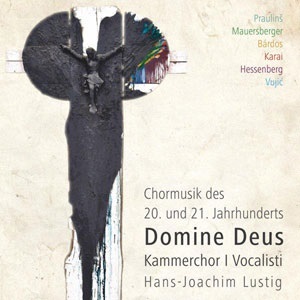Von Jonathan Slawson, Journalist
Kammerchor I Vocalisti
Leitung Hans-Joachim Lustig
Mit ihrer neuesten CD, Domine Deus (Herr unser Gott), bietet der Kammerchor I Vocalisti ein fantastisches musikalisches Porträt von Jesus Christus mittels alter biblischer Texte, die durch zeitgenössische A-cappella Kompositionen mit neuem Leben erfüllt werden. Durch die intensive Beschäftigung mit der Musik und in enger Zusammenarbeit mit den Komponisten (die alle noch leben) haben die Künstler ein besonderes Verhältnis zu der Musik entwickelt.
Die CD besticht durch intonationssichere Klarheit und gut durchdachte musikalische Kunstfertigkeit. Den Rahmen bilden Ugis Praulins Vertonung der lateinischen Messe „Ordinarium missae“ zu Beginn und die überwältigende Vertonung des Vaterunsers von Aleksander S. Vuhic am Schluss. Alles andere dazwischen handelt auf einzigartige und eindringliche Weise von Gott oder Jesus Christus. „Sie schildern Gott in allen Aspekten der Lebenslagen von Menschen: mal flehend, dann wieder lobpreisend oder dankbar empfangend, dann wieder in verzweifeltem Kampf ums Dasein.“
Lassen Sie sich von ihrer Musik an einen kontemplativen, ruhigen und besinnlichen Ort versetzen, ohne jedoch dabei drei besondere musikalische Leistungen aus dem Auge zu verlieren, die den Kammerchor I Vocalisti aus den Spitzenchören der Welt hervorhebt: ihr Gespür für Phrasierung, die Einheitlichkeit in der Behandlung der Vokale sowie ihre Notentexttreue.
Jedes Stück dieser Aufnahme wird mit einem bezwingenden musikalischen Spannungsbogen gesungen, wodurch jede Phrase, jede Zeile, jede Note vorwärts zu drängen scheint. Ob dies das Verdienst des Komponisten, des Chorleiters, der Sänger oder aller gemeinsam ist, bleibt dahin gestellt. Wie dem auch sei, das verleiht jedem Stück, vor allem mit diesem delikaten religiösen Text, eine ungeheure Dramatik, was zuerst im Gloria (Spur 2) spürbar ist. Nach anfänglichen spielerischen Annäherungen zwischen den Frauen- und Männerstimmen vereinigen diese sich schließlich, beginnend mit „Laudamus te, benedicimus te, adoramus te, glorificamus te…“. Die Verwendung von abgedunkelten Vokalen verleiht jeder Phrase und jeder Zeile einen Bogen, was das Gloria zu einer aufregenden Interpretation macht. Tatsächlich unterstreichen die vielen musikalischen Höhepunkte dieser CD die Dramatik in allen Stücken. Detailfreudigkeit im Großen und Kleinen ist entscheidend, vor allem, wenn ein Ensemble religiöse Texte außerhalb eines liturgischen Kontextes darbietet.
Zweitens aber, und es sei Ihnen gestattet, das anders zu sehen, ist meiner Meinung nach für die genaue Intonation eines Chores von größter Wichtigkeit die Fähigkeit Vokale abzuwandeln, damit alle gleichzeitig dasselbe singen. Dem Kammerchor I Vocalisti gelingt dies außergewöhnlich gut. Viele Chorleiter meinen, der einfachste Weg, einen Chor in Einklang zu bringen, sei der, die Vokale möglichst geschlossen zu singen, damit wenig Raum für Abweichungen bleibt. Tatsächlich aber singt der Kammerchor I Vocalisti geschlossene und offene Vokale so rein, weil eben alle demselben Klangideal verpflichtet sind. Ihr reicher Klang und ihre nahezu perfekte Intonation werden weitgehend dadurch erreicht.
Schließlich geht es dem Kammerchor I Vocalisti um die Vermittlung des musikalischen Textes. Es klingt wie eine Binsenweisheit: man muss wissen, was man singt. Oft genug trifft man jedoch auf Chöre (vor allem Amateurchöre), die beim Singen der Phonetik des Textes zu wenig Aufmerksamkeit schenken. In dem Begleitheft der CD vermerkt Hans-Joachim Lustig, dass der Chor sich intensiv sowohl mit dem Studium der Musik wie auch des Textes beschäftigt hat. Ihr musikalisches Wissen ist offensichtlich und kommt ihrer Musikalität zugute.
Herzlichen Glückwunsch zu dieser wunderbaren CD!
 Jonathan Slawson erwarb seinen Bachelor of Music am Westminster Choir College (USA) und studiert momentan in einem Masterstudiengang Nonprofit Management. Seine beruflichen Interessen liegen in der Kunsterziehung, der Politik und im Management. Er ist Berater der Entwicklungsabteilung für die Bravo Lincoln Center Kampagne, die Hauptkampagne zur Erlangung der nötigen Gelder für die Sanierung des Lincoln Center (New York). Davor war er für die Leitung des Lincoln Centers und dessen Beziehungen zur Bevölkerung verantwortlich. Daneben hat er für Disney’s und In Tune Monthly geschrieben, arbeitete als Herausgeber des Lehrerführers bei New World Stages (Stage Entertainment) und an einem Theater. Er unterrichtete Musik an der Maureen M. Welch Grundschule, am New Jersey Performing Arts Center und am Stagestruck Performing Arts Center. Jonathan Slawson ist Mitglied des Akademierats der Blair Academy of Governors und erhielt 2009 den Preis des Präsidenten des Westminster Choir College, die höchste Auszeichnung der Universität.
Jonathan Slawson erwarb seinen Bachelor of Music am Westminster Choir College (USA) und studiert momentan in einem Masterstudiengang Nonprofit Management. Seine beruflichen Interessen liegen in der Kunsterziehung, der Politik und im Management. Er ist Berater der Entwicklungsabteilung für die Bravo Lincoln Center Kampagne, die Hauptkampagne zur Erlangung der nötigen Gelder für die Sanierung des Lincoln Center (New York). Davor war er für die Leitung des Lincoln Centers und dessen Beziehungen zur Bevölkerung verantwortlich. Daneben hat er für Disney’s und In Tune Monthly geschrieben, arbeitete als Herausgeber des Lehrerführers bei New World Stages (Stage Entertainment) und an einem Theater. Er unterrichtete Musik an der Maureen M. Welch Grundschule, am New Jersey Performing Arts Center und am Stagestruck Performing Arts Center. Jonathan Slawson ist Mitglied des Akademierats der Blair Academy of Governors und erhielt 2009 den Preis des Präsidenten des Westminster Choir College, die höchste Auszeichnung der Universität.
Wenn Sie daran interessiert sind, dem International Choral Bulletin eine CD zur Kritik vorzuschlagen, wenden Sie sich bitte an Jonathan Slawson über jonathan.ryan.slawson@gmail.com
Übersetzt von Ursula Wagner, Frankreich


